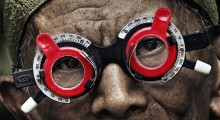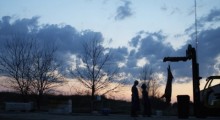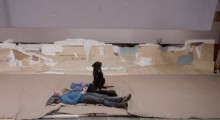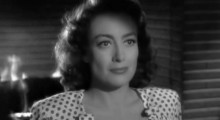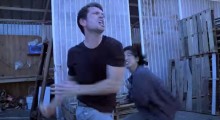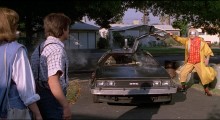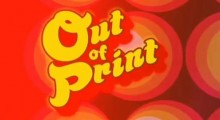Filmmaker Videos
-
Trailer Watch: Joshua Oppenheimer’s The Look of Silence

Formally exacting where The Act of Killing was dazzlingly brazen, The Look of Silence is no less staggering of a feat than its talked-about predecessor. Joshua Oppenheimer’s unflinching look at the victims behind the Indonesian genocide will not hit theaters until next Spring, but the documentary continues to ride a nice critical wave from the fall festival circuit, where it picked up the FIPRESCI prize in Venice, amongst other plaudits. I, too, was wowed by the film’s unflinching probe of military and neighborly antagonization at my NYFF viewing, and look forward to revisiting it in the coming months.
-
(New) Trailer Watch: Stanley Kubrick’s 2001

The match cut, “Also Sprach Zarathustra,” HAL — it’s all here, along with praise from Christopher Nolan and Alfonso Cuaron, in this brand new trailer for Stanley Kubrick’s classic 2001. Here’s the Hollywood Reporter: Ahead of the digitally restored film’s special limited U.K. release on Nov. 28 as part of the British Film Institute’s “Sci-Fi: Days of Fears and Wonder” season, a new trailer commission by the BFI and Warner Bros. has now been unveiled. Created by Ignition Creative London, the trailer is the first for this title in four decades, and uses Hal as the central figure to create […]
-
Bold Choices: Making the “Film-to-Table” Short Film, The Slaughter

It’s March 2012. I’m standing outside a warehouse with 18 people. We’re about to watch a pig die. Three cameras are ready to roll: two for the movie and one for legal purposes. My actors have the morning off; because of my agreement with SAG, they’re not allowed to be on set for this particular scene. Rory Royston, the operator of an independent slaughterhouse, as well as his assistant, stand in for my lead actors, dressed in their wardrobe; they will make sure the slaughter about to be performed is both safe and humane. Rory looks to me; it’s time. […]
-
Watch: How to Build a Beach on a Soundstage (for A Pigeon Sat on a Branch Reflecting on Existence)

How precisely does one go about building an entire beach on a soundstage? That’s one of the many challenges posed by master Swedish director Roy Andersson’s regular working method, which involves constructing meticulous sets to stage his mordant tableaux and droll takes on despair and death. This brief video shows his crew building a beach from the ground up — not a photo-realistic set, but pretty close, complete with meticulous arrangement of sand and one friendly dog roaming around. A Pigeon Sat on a Branch Reflecting on Existence will be released here next year by Magnolia Pictures.
-
Watch: Film Noir as a Subversion of Melodrama

Noir is a “challenge to dominant values,” according to critic Peter Labuza in this concise visual essay on one of cinephiles’ favorite “modes.” Bridging The Classical Hollywood Cinema with the writings of Linda Williams, Labuza considers film noir as a method of subverting the building blocks of melodrama, thus imbuing its viewers with a “feeling of displacement.” Perhaps most disorienting is that in everything from Mildred Pierce to My Name is Julia Ross, there is no weepy sense of satisfaction for the taking.
-
Afternoon Smackdown: Pre-Vis’ing a Fight Scene

Action cinematographer Lawrence Ribeiro forwards this short video of an afternoon’s work — literally. Below, he explains how, with a camera and two top stuntmen, he can mock-up a dynamic fight scene. From Ribeiro: Here’s a chase and fight sequence we shot, in five hours, using two top stunt professionals and one camera. In 2nd unit, we’d consider this type of shooting a level above pre-visualization (previs). Previs is a critical tool for designing action sequences. Sometimes all a script will say is, “…and they fight.” So videos like this allow us to experiment with choreography, and save time and […]
-
See No Evil 2 Directors The Soska Sisters on Collaborative Directing

In the upcoming issue of Filmmaker, Esther Robinson writes about directors who work in pairs. Robinson’s focus is on how two directors is better than one when it comes to navigating the development and financial aspects of being a director, and she surveys a number of them on how they structure their work. But then there’s the also the basic question: how do they actually do it? Is everything discussed jointly? Does one talk to the actors and the other direct the camera? Is one more dominant in production and the other in post? In this short clip, Jen and […]
-
Watch: How to Create a Forced Perspective

Distance from Camera x Scale of Model=Distance between Foregrounded Model and Background. That simple bit of arithmetic, as illustrated in the latest Shanks FX episode, is all you need to achieve an accurate “forced perspective.” The technique, recognizable from Back to the Future and myriad 80’s blockbusters, allows for the manipulation of objects to appear larger/smaller or farther/closer than they actually are. In other words, it’s VFX done on the (relative) cheap.
-
Watch: LG’s 34-Inch 21:9 34UC97 Curved Monitor Provides More Pixel Power without Color Shift (Sponsored Post)

The following is a sponsored editorial post from LG. For editors looking to limit the number of screens they’re looking at, LG’s 21:9 ratio 34UC97 monitor is an exciting new option. At 34 inches wide with QHD resolution of 3440×1440, the 34UC97 provides 2.4 times more pixel power than a 16:9 monitor with full HD resolution. Editors worried about the color shift that can occur on the edges of ultrawide monitors won’t have that problem with the 34UC97, whose IPS panel is specifically designed to prevent color inconsistencies at the corners caused by VA monitors. That means you don’t have […]
-
Watch: New Beverly Ex-Manager Julia Marchese’s Documentary on 35mm and Rep Cinema

For many years one of the public faces of Los Angeles’ New Beverly Cinema, today Julia Marchese posted an unnerving account of her experience since Quentin Tarantino became the theater’s owner and programmer. It’s worth reading in full, but the gist is that Tarantino’s team put inexplicably tight social media muzzles on all staff and effectively fired (“demoted”) Marchese less than two weeks after her promotion to a managerial role. In short: her hopes dashed for a New Beverly 35mm premiere of her documentary Out of Print — about the importance of 35mm repertory cinema in general and the theater […]
